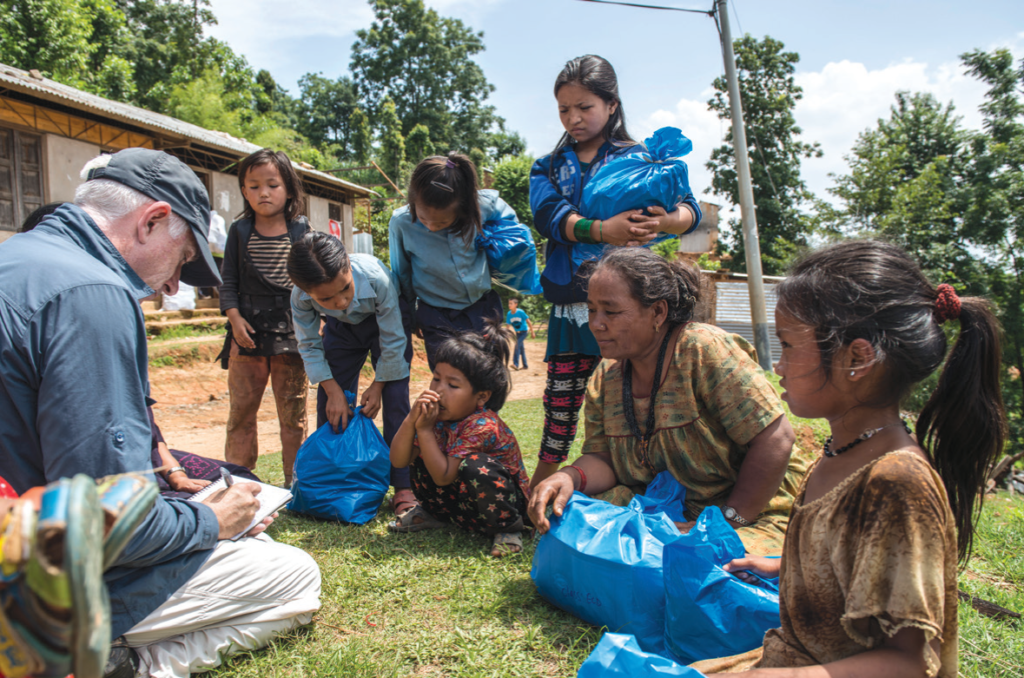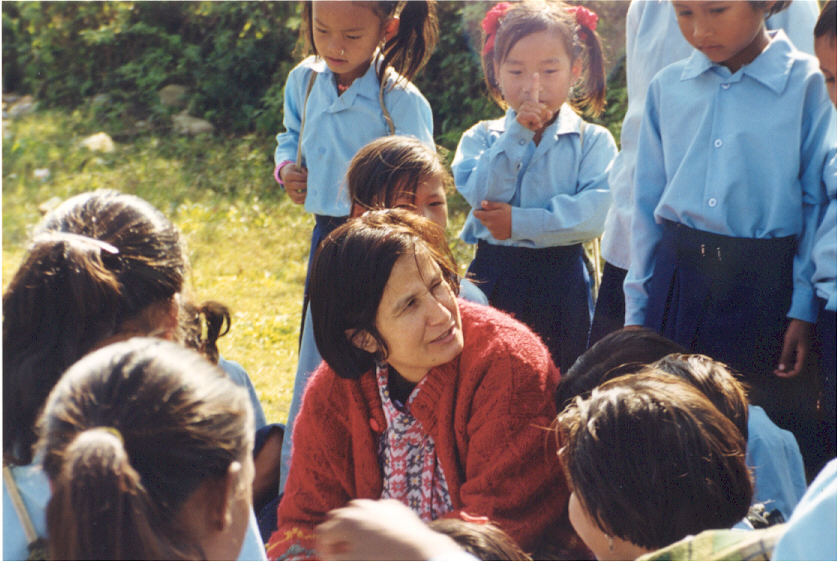We know that the success of anything worth doing rides on the vision, courage, and commitment of exceptional leaders. Exceptional leaders are the cornerstone for building businesses and for broad humanitarian impact.
Aruna Uprety is a classic exceptional leader. We’ve mentioned her briefly in previous posts. She created a program in her homeland, Nepal, that across more than twenty years has helped educate and protect 20,000 girls from human traffickers. (That’s Aruna with some of her charges in the photo above.)
Her life story is just as inspiring. She has been an intrepid activist for improving women’s health and education for years: unflinching in confronting repressive sexist mores that persist in this male-dominated society, from rural hamlets to the halls of national government in Kathmandu.
Trained as a physician in the Soviet Union, she advises international health organizations, and continues to research, write, and practice medicine in remote areas.
Best-selling author Jon Krakauer, a longtime Aruna fan, observes that she is motivated by facts and science as well as personal experience, knowing that dedicating more resources for women in poor cultures will lift the wider society.
“If you help women in a culture like this, that investment pays real dividends,” Jon says. “Because when you help women, you help everybody.” The best programs in global development embrace the same principle: Women invest in the health and education of their families.
You can see in Aruna’s own story how this courageous, diminutive woman was drawn to her life’s purpose. Her mother was married when she was only ten years old to a man who became a prominent lawyer. The man forbid her from going to school, but she was determined that her three children get a good education, including Aruna and a sister who would become a teacher.
After high school, though, Aruna was largely on her own financially. A bus costing less than 10 cents a day would have made the daily commute to her pre-medical college easy. But she didn’t have the money, wasn’t given the money, and had to walk…one hour each way, every day.
Even so, she posted stellar grades – not good enough to win her dream scholarship to one of India’s top medical schools, but good enough to be offered a full ride in the Soviet Union, where women often pursued careers in science and medicine.
Accepting an intense, failure-is-not-an-option challenge to learn Russian, she studied for seven years in Moscow and Ukraine’s Kharkov, a city near the Russian border then home to the Soviet Union’s oldest medical school. Medical diploma in hand, she became in 1986 one of the few women of her generation in Nepal to complete an advanced education and pursue a medical career.
The young Dr. Uprety focused on public health issues for several years in India near the Nepal border, followed by postings with international health organizations in Afghanistan, Laos, Sri Lanka, Tibet, Iran, and Sudan.
Aruna saw in many cities and villages the same fear and desperation among young women she encountered in India and Nepal. This stemmed not only from abuse by other family members. Young women feared being sold into slavery or bonded labor by parents who couldn’t afford a dowry.
Ignorance and old traditions trample possibilities for more independent lives and respect that education offers girls.
Many Nepali girls were pained and disheartened to hear their fathers repeat an old saying: Educating your daughter is like watering a flower in another man’s garden.

Our regional field director, Bruce Moore, with girls holding emergency relief bags filled with clothes and school supplies a few months after the 2015 earthquakes.
Twenty-five years ago, the most haunting image of trafficking in Nepal was AIDS victims dying in India’s brothels. The Gulf countries, Africa, and Tibet are part of the cross-border picture that now includes unsafe labor migration and bride trafficking to Korea and China. Humanitarian groups estimate between 7,000 and 15,000 Nepali girls are trafficked yearly. Within Nepal, more young girls are migrating to cities, where they are vulnerable to abuse as housemaids for the wealthy.
Aruna still sees her friends from pre-med days. One was awarded the same scholarship to study in the Soviet Union, but, forced by her parents to turn it down, never accepted. Too far, too many years, her parents lectured. “You will be too old then to get married.” Most of these friends did marry long ago, leaving behind dreams of careers, of passionate causes.
With a slight hint of annoyance, Aruna says they all tell her she was fortunate “to have had this type of life.” She agrees, to a point, but the years and different paths have left a fissure. Her old friends are too blithe. “They think it is an easy thing. But they have not seen the struggle. I really had to work very, very hard.”
Every act of Aruna’s incredible devotion to keeping thousands of girls informed, protected and educated has been given freely, without compensation. She is, and always has been in this work, a volunteer.
We’re excited to have Aruna, Jon Krakauer, National Geographic’s 2016 Adventurer of the Year Pasang Lhamu Sherpa Akita, and award-winning journalist and film maker Subina Shrestha as speakers at our annual dinner to raise funds for STOP Girl Trafficking. This year’s event in San Francisco is in two weeks… March 23.
The cost to protect and educate one girl for a full year in this remarkable partnership with Aruna is $100.
“In this country, we have resources,” says Jon. “By sparing just a very small amount of these resources you can make a difference in a far corner of the world.”
To learn more about STOP Girl Trafficking, please visit the American Himalayan Foundation blog.
Photos courtesy of the American Himalayan Foundation


Leave a Reply